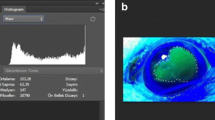Abstract
Corneal wound healing is an important process that involves interaction between the different corneal cell layers, growth factors, and environmental conditions. More powerful therapies for the treatment of delayed epithelial wound healing are still being proposed. The objective of this study is to investigate the effects of the direct-acting parasympathomimetic agents on the healing process of corneal epithelium in rabbits. The corneal epithelial defects, 10 mm in diameter, were created in 32 eyes of 16 island rabbits by combination of chemical debridement using n-heptanol and mechanical scraping. Animals were randomly divided into four groups. Groups 1, 2 and 3 were treatment groups; each group consisted of four rabbits (8 eyes). The animals in these groups were treated with topical 1% acetylcholine (ACh), 2% pilocarpine, and 0.75% carbachol drops respectively. In group 4, four rabbits (8 eyes) were used as control group and left for spontaneous healing. The length and area of the defect were measured at days 3,6,9,12,15,18 and 22 after wounding. Areas of the photographically documented fluorescein-stained defects were measured by planimetry. All eyes in the treatment groups reepithelialized completely. The duration for reepithelialization in Groups 1 and 2 was 12 days, and 18 days for Group 3. In the control group reepithelialization occurred within 22 days. The healing rates of corneal epithelium were statistically significantly faster in all treatment groups as compared with the control group at all times (p=0.0001 to 0.0279). Although the rates of wound healing varied, all of the parasympathomimetics used in the present study were found to facilitate wound healing. Our results indicate that direct-acting cholinergic agents, especially ACh and pilocarpine, may have an important therapeutic role in the treatment of severe corneal epithelial injury.
Similar content being viewed by others
References
Arffa RC. Grayson's Diseases of the Cornea. Third ed. Boston: Mosby 1991: 324–32.
Saika S, Uenoyama K, Hiroi K, Tanioka H, Takase K, Hikita M. Ascorbic acid phosphate ester and wound healing in rabbit corneal alkali burns: epithelial basement membrane and stroma. Graefes Arch Clin Exp Opthalmol 1993; 23: 221–7.
Hayashi K, Berman M, Smith D, Ghatit A, Pease S, Kenyon KR. Pathogenesis of corneal epithelial defects: role of plasminogen activator. Curr Eye Res 1991; 10: 381–98.
Simsek NA, Manav G, Tutkun IT, Basar D, Bilgin LK. An experimental study on the effect of collagen shields and therapeutic contact lenses on corneal wound healing. Cornea 1996; 15: 612–6.
Puchkovska NA, Shulgina NS, Nepomyaschachaya VM. The pathogenesis and treatment of eye burns and their sequelae. Mir publisher, Moskov, 1976: 90–105.
Walkenbach RJ, Ye GS. Muscarinic cholinoceptor regulation of cyclic quanosine monophosphate in human corneal epithelium. Invest Ophthalmol Vis Sci 1991; 32: 610–15.
Walkenbach RJ, Ye GS. Muscarinic receptors and their regulation of cyclic GMP in corneal endothelial cells. Invest Ophthalmol Vis Sci 1990; 31: 702–7.
Lind GJ, Cavanagh HD. Identification and subcellular distribution of muscarinic acetylcholine receptor-related proteins in rabbit corneal and chinese hamster ovary cells. Invest Ophthalmol Vis Sci 1995; 36: 1492–1507.
Colley AM, Cavanagh HD, Drake L, Law M. Cyclic nucleotides in muscarinic regulation of DND and RNA polymerase activity in cultured corneal epithelial cells of the rabbit. Curr Eye Res 1985; 4: 941–50.
Cintron C, Hassinger L, Kublin CL, Friend J. A simple method the removal of rabbit corneal epithelium utilizingn-heptanol. Ophthalmic Res 1979; 11: 90–6.
Tsai RJF, Sun TJ, Tseng SCG. Comparison of limbal and conjunctival autograft transplantation in corneal surface reconstruction in rabbits. Ophthalmology 1990; 97: 446–55.
Kenyon KR, Tseng SCG. Limbal autograft transplantation for ocular surface disorders. Ophthalmology 1989; 96: 709–22.
Newton C, Hatchell DL, Klintworth GK. Effect of topical fibronectin on corneal epithelial wound healing. ARVO Abstracts. Invest Ophthalmol Vis Sci 1984; 25(suppl):78
Schultz GS, Davis JB, Eiferman RA. Growth factors and corneal epithelium. Cornea 1988; 7: 96–101.
Watanabe AM. Cholinoceptor-activating drugs. In: Katzung BG: Basic and Clinical Pharmacology. Fourth ed. Middle East: Lange, 1989: 70–82.
Colley AM, Law ML. Effects of carbamylcholine on cyclic nucleotide-dependent protein kinase activity in corneal epithelium during resurfacing. Metab Ophthalmol 1987; 10: 73–5.
Lind GJ, Cavanagh HD. Nuclear muscarinic acetylcholine receptors in corneal cells from rabbit. Invest Ophthalmol Vis Sci 1993; 34: 2943–52.
Baserga R. Cell Growth and Division. Second ed. Oxford: Irl Press 1990: 1–16.
Morton ME, Nathanson NM. Regulation of cardiac MAChR expression and function by insulin. Soc Neurosci Abst 1991; 17: 1529.
Gasset AR, Ishii Y, Kaufman HE, Miller T. Cytotoxicity of ophthalmic preservatives. Am J Ophthalmol 1974; 78: 98–105.
Imperia PS, Lazarus HM, Botti RE, Lass JH. Anin vitro method for measuring ophthalmic preservative cytotoxicity. J Toxicol Cut Ocular Toxicol 1986; 5: 309–17.
Berdy GJ, Abelson MB, Smith LM, George MA. Preservative-free artificial tear preparations. Arch Ophthalmol 1992; 110: 528–32.
Tonjum AM. Effects of benzalkonium chloride upon the corneal epithelium studied with scanning electron microscopy. Acta Ophthalmol 1975; 53: 358–66.
Tripathi BJ, Tripathi RC, Kolli SP. Cytotoxicity of ophthalmic preservatives on human corneal epithelium. Lens & Eye Toxic Res 1992; 9: 361–75.
Burnstein NL, Klyce SD. Electrophysiologic and morphologic effects of ophthalmic preparations on rabbit cornea epithelium. Invest Ophthalmol Vis Sci 1977; 16: 899–911.
Author information
Authors and Affiliations
Rights and permissions
About this article
Cite this article
Hamdi, E. The effect of topical parasympathomimetics on corneal epithelial healing in rabbits. Doc Ophthalmol 93, 327–335 (1997). https://doi.org/10.1007/BF02569070
Accepted:
Issue Date:
DOI: https://doi.org/10.1007/BF02569070




